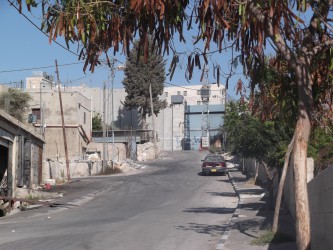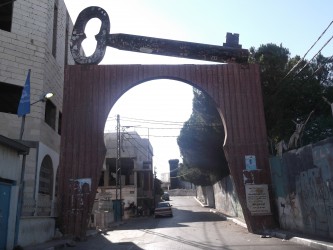Aida is a refugee camp in Palestine, a mere ten minutes from Bethlehem. What it is also close to is Al’ Quds, which in Arabic means ‘Jerusalem’. This is where twenty-three international volunteers and I had been selected to work in a summer volunteer programme, run by the Lajee centre. Its inhabitants live within the walking distance of their Holy City and yet they have been forbidden to travel there by the Israeli forces. There are refugees from thirty-four villages, which are now occupied land. The road to Aida has a wall painted with images from each of these places. The first time we walked by the memorial, I found the paintings beautiful but once it sunk in that they represent the homes of Aida’s residents, homes, which don’t exist anymore, I found them harder to look at with each passing day.
During our stay we worked and lived with Palestinian volunteers from Aida who helped us learn and have fun at the same time. They taught us how to dance Dabke, which terrified us after watching the amazing way the experienced Dabkers do it! It was okay though; they let us learn the easy moves. They also taught us Arabic, or at least they tried. I certainly was not very good at it, no matter how hard I practiced, but at least I mastered ‘Marhaba!’ which means ‘Hello.’ We were treated to home cooked meals every day, usually by one of the mothers of the volunteers, sometimes we even got chips or spaghetti to make us feel at home. It was as though we were one big family; we danced together, ate together and even napped together. Our evenings were like huge parties. The days, on the other hand, were hard and long. We went to lectures from various organisations who shared their experiences of the conflict and how they now work within it to help the affected people. We heard from medical personnel, people who knew about education and even from the government in regards to the treatment of prisoners.
One thing which I have not been able to forget since I arrived back, though, was the playground at the Lajee Centre. It’s a place where children from the refugee camp can come to play, read, or take classes in dance and art. It is a safe place where children get to be children. Our role was to clear up the ground, take away the rocks so that eventually they could form part of the wall around the playground. Generally helping out with the upkeep of the Centre proved difficult at times; even menial tasks like watering the plants had a new dimension to it since it was common knowledge the water flow was controlled from Israel. We weren’t only responsible for looking after the actual playground though; we also got to help out with the kids. Of course the language barrier was a little difficult to overcome, but with the help of our Palestinian friends we managed to get to know some of them pretty well. Overall, this playground was a place for us to give something to these children, teach them our games but mostly just play with them and have fun.
There is something I feel is very important to share about this playground. I did not notice it immediately, but as soon as I did, I could not un-notice it no matter how hard I tried. Aida lies next to the wall, which separates Palestine from Israeli-occupied territory. Periodically along this wall, you can see army watchtowers. The wall is huge, around eight feet high, and the towers just add to its terrifying presence. Three of those watch towers could see straight into the playground. One day I was taking photographs of the football games, when I noticed one of them over the top of the field. After that I realised there was another one behind the swing set. Soon I found myself focussing on these towers when we were supposed to be playing with the kids. I never once saw a child glance at them but they are used to it by now, for me though this was something sinister and wrong. The very idea that Israel’s army looms over the children like that in their place of peace and fun really angered me.
(left-click for an enlarged version of photos)
The whole of Aida camp is under surveillance and not far from the main entrance into Aida is the gate which the Israeli army come through whenever they go into the camp. The Lajee centre and the playground sit right between these two spots. The children, as well as the adults and the elderly of Aida live never really knowing if the army is going to come through today, or not. The camp as well as Lajee has seen plenty of interventions and the local photographer, who was shot in the face with a rubber bullet not long before our arrival in Palestine, caught footage of these attacks.
Within half an hour of being home, I heard news that an eleven-year-old boy from Aida had been shot in the head with non-lethal ammunition. After a few stitches he was fine, but other children have not been so lucky. Lajee’s security cameras captured footage of a child being shot dead in front of the centre. Children aged twelve can be arrested by the Israeli Armed Forces and held in solitary confinement. Many of those who we played with were much younger than that, but this was a glimpse of their future if no change takes place. I look at the pictures of myself pushing little girls on swings, or of my friend helping kids to draw cats and all I can see now are the Watchtowers; with their eyes on the playground, and the children who will grow up to be their next targets.
The gate to Aida bears the Lock and Key of Return. This symbolises the return of Palestine as a country and Palestinians to their homes. It is a powerful symbol and one, which shows that Palestine has not given up. Its countrymen are very much determined to gain back their land, even if their homes are no longer a part of it. I am proud to have worked with such wonderful and inspirational people, and I look forward to the day when I can return to Palestine and help them tear that wall down, away from the playground. I doubt even then, though, that the image of the Watchtower and the playground will ever leave my mind. A part of me hopes it never does.
words by Robyn Lee




A great piece, Robyn, well done. Very vividly written and sensitively put. Such a difficult situation. Here’s more power to your pen. A